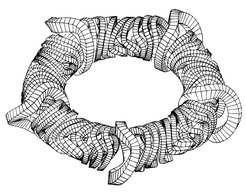
Stellarator
In a stellarator the magnetic cage is produced with a single coil system – without a longitudinal net-current in the plasma and hence without a transformer. This makes stellarators suitable for continuous operation, whereas tokamaks without auxiliary facilities operate in pulsed mode.

Dispensing with the ring-shaped plasma current means, however, abandoning the axial symmetry present in tokamaks. As the helical twisting of field lines is achieved solely with external coils, the later have to be twisted accordingly: the magnet coils and plasma have a complicated shape. This, however, affords additional freedoms in shaping the magnetic field and making it properties accessible to optimisation.
In order to overcome the deficiencies of previous stellarators, IPP conducted a systematic search for the optimum magnetic field. For more than ten years the Stellarator Theory Group investigated the wide area of possible stellarator configurations. The outcome is the optimised magnetic field of Wendelstein 7-X: The quality of plasma equilibrium and confinement will be on a par with that of a tokamak.
For a fusion power plant stellarators could provide a technically simpler solution than what tokamaks might achieve. This question cannot be answered by theoretical means; clarifying it experimentally is the objective of the Wendelstein experiments at IPP.
